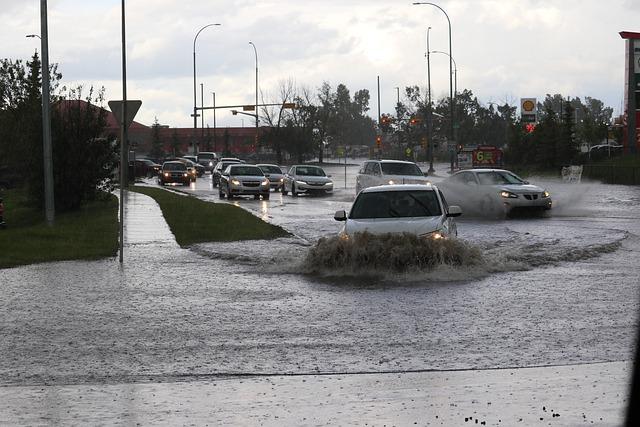In recent weeks, severe flooding has wreaked havoc across chad, Nigeria, and Cameroon, displacing millions and exacerbating the already critical humanitarian situation in the region. Torrential rains have overwhelmed rivers and waterways, leading to devastating consequences for vulnerable communities that depend on agriculture and stable living conditions for survival. Action Against Hunger, an association dedicated to combating malnutrition and food insecurity, has mobilized its resources to respond to the growing crisis. As families are forced to flee their homes and seek refuge in makeshift shelters, access to food, clean water, and healthcare has become increasingly precarious. This article delves into the extent of the flooding, its impact on the affected populations, and the urgent response efforts underway to alleviate suffering in these hard-hit areas.
Severe Flooding Crisis: The Impact on Communities in Chad,Nigeria,and Cameroon
Recent severe flooding in Chad,Nigeria,and Cameroon has resulted in a humanitarian crisis affecting millions of residents. The torrential rains have caused rivers to overflow, leading to the destruction of homes, vital infrastructure, and agricultural land. As communities grapple with rising water levels, they face numerous challenges, including:
- Displacement: thousands have been forced to evacuate their homes, seeking refuge in temporary shelters or with relatives.
- Food Insecurity: Flooding has devastated crops, disrupting local food supplies and threatening livelihoods.
- Health Risks: Standing water has become a breeding ground for waterborne diseases, increasing the risk of outbreaks.
In response to this crisis,various organizations are mobilizing to provide immediate relief and long-term support. Efforts include distributing food, clean water, and hygiene supplies, as well as promoting preventive healthcare measures. Below is a summary of the critical assistance being provided:
| Country | Assistance Provided | Beneficiaries |
|---|---|---|
| Chad | Food aid and shelter materials | 500,000+ |
| Nigeria | Access to clean water and sanitation | 300,000+ |
| Cameroon | Healthcare services and education support | 200,000+ |
Emergency Response Efforts: Assessing the Role of Action Against Hunger
The recent catastrophic flooding in Chad, Nigeria, and Cameroon has prompted an immediate and robust response from Action Against Hunger, an organization renowned for its commitment to combating hunger in crisis situations. Their teams have mobilized to provide essential assistance and support to the millions affected. Key initiatives include:
- Emergency Food Distribution: Delivering immediate food aid to the most vulnerable populations.
- Access to Clean Water: Setting up water distribution points and sanitation facilities to prevent waterborne diseases.
- nutrition Support: Providing nutritional supplements to malnourished children and lactating mothers.
- Community engagement: Initiating local awareness programs about health and hygiene practices.
Along with these efforts, Action against Hunger is actively working with local governments and othre humanitarian organizations to assess the long-term impact of the flooding and coordinate sustainable recovery initiatives. The organization emphasizes the importance of a multidimensional approach in crisis management, which includes:
| Focus Area | Action Taken | expected Outcome |
|---|---|---|
| Food Security | Rapid food distribution | Reduce immediate hunger |
| Health & nutrition | Mobile health clinics | Prevent malnutrition |
| Water & Sanitation | Install temporary latrines | Minimize disease outbreak |
| Community Recovery | Skill workshops | Promote livelihood recovery |
Long-Term Solutions: Strategies for Flood Resilience in Vulnerable Regions
Building flood resilience in regions significantly affected by severe flooding necessitates a multifaceted approach that combines infrastructure enhancement, community engagement, and sustainable environmental practices.Improved drainage systems and flood barriers are crucial for managing rising water levels during heavy rainfall. Investing in nature-based solutions, such as restoring wetlands and rehabilitating floodplains, can play a pivotal role in absorbing excess water while sustaining local ecosystems. additionally, establishing early warning systems empowers communities by providing timely facts, enabling them to take proactive measures before disasters strike.
Community education and involvement are equally critical in mitigating the risks associated with flooding.Local leaders should be trained to develop and implement disaster response plans, ensuring readiness in times of crisis. Moreover, programs promoting sustainable agricultural practices can help safeguard food security while reducing soil erosion. Engaging in collaborative partnerships among government agencies, NGOs, and the private sector enhances resource allocation and knowledge sharing, creating a more robust infrastructure for disaster preparedness and recovery. Striving for these long-term solutions can significantly bolster resilience against the adverse effects of flooding in vulnerable regions.
Health Risks and Food Insecurity: Addressing Immediate Needs of Affected Populations
In the wake of the devastating floods,the health risks faced by affected populations are escalating at an alarming rate. The standing water serves as a breeding ground for disease vectors, leading to increased occurrences of illnesses such as cholera, malaria, and typhoid fever. Vulnerable groups, including children and the elderly, are particularly at risk. Furthermore,the flooding has disrupted access to essential health services,complicating treatment and prevention efforts. Essential preventive measures, such as vaccinations and sanitation promotion, are hampered, exacerbating the public health crisis. Immediate interventions must focus on:
- Strengthening disease surveillance: To monitor outbreaks effectively.
- Distributing medical supplies: Ensuring clinics have necessary resources to treat patients.
- Enhancing community awareness: Educating populations on hygiene and disease prevention.
Food insecurity has sharply increased as agricultural activities are severely disrupted, leaving many without access to adequate nutrition. Malnutrition poses a serious danger, particularly among children who are already weakened by the ongoing health crisis. The loss of livelihoods and the destruction of crops mean that families are struggling to meet even their basic food needs. Emergency food assistance and nutritional support must be prioritized, particularly for the most vulnerable. A structured response effort should include:
| Immediate Actions | Target Groups |
|---|---|
| Distribution of food aid | Households with children under five |
| Provision of cash transfers | Single-parent families |
| Set up nutrition centers | Pregnant and lactating women |
Call to Action: Mobilizing Support for Flood Relief and Recovery Initiatives
The recent catastrophic flooding in Chad, Nigeria, and Cameroon has left millions in urgent need of humanitarian assistance. As communities face displacement, food shortages, and health crises, your support is vital. Here’s how you can contribute:
- Donate: Every contribution helps provide immediate relief. Your funds can supply food, clean water, and essential medical care to those affected.
- Spread the Word: Sharing information about the crisis and our initiatives can mobilize others to act. Use social media platforms to increase awareness and inspire action.
- Volunteer: Join local efforts or partner organizations focused on providing relief. Your time and skills can make a difference in recovery efforts.
- Advocate: Reach out to local leaders and encourage policies that support disaster relief funding and sustainable recovery strategies.
To illustrate the scale of the crisis, here’s a simple breakdown of resources needed:
| Resource | Quantity Needed |
|---|---|
| Food Packs | 250,000 |
| Water Purification Units | 5,000 |
| Medical Kits | 10,000 |
| Temporary Shelters | 15,000 |
By joining hands, we can help rebuild lives and restore hope in these overwhelmed communities. Your involvement can pave the way for effective recovery and resilience in the face of such natural adversities.
Preventing Future Disasters: Lessons Learned and Recommendations for Policy Makers
In light of the recent catastrophic flooding affecting millions in chad, Nigeria, and Cameroon, it is indeed imperative for policy makers to glean critical insights that can fortify future disaster preparedness and response efforts. The following lessons learned emerge as pivotal in shaping effective strategies:
- Community Engagement: Involving local communities in disaster planning ensures that responses are tailored to specific needs and maximize local resources.
- early Warning Systems: Investing in advanced meteorological technology can significantly enhance early warning systems, providing at-risk populations with crucial time to evacuate or take preventive action.
- Infrastructure Resilience: Policies focused on strengthening infrastructure—such as drainage systems and flood barriers—are essential to mitigate the impact of extreme weather events.
- Integrating Climate Change Strategies: Recognizing climate change as a driving force behind increased flooding is crucial for developing long-term adaptation strategies.
Additionally, it is essential for governments to prioritize collaboration with humanitarian organizations and NGOs to ensure a coordinated response to disasters. A proposed framework includes:
| Key Initiative | Description |
|---|---|
| Disaster Risk reduction Training | Educating communities on disaster preparedness to enhance resilience. |
| Resource Allocation | ensuring funding for emergency relief is readily available and efficiently distributed. |
| Policy Review mechanisms | Establishing periodic reviews of disaster response policies to incorporate new insights and technologies. |
By implementing these recommendations, policy makers can better safeguard vulnerable populations against the intensifying threats posed by flooding and other climate-related disasters, fostering a culture of resilience and proactive preparedness.
Wrapping Up
the severe flooding across Chad, Nigeria, and Cameroon has unleashed a humanitarian crisis, affecting millions and exacerbating existing vulnerabilities in the region. As communities grapple with the devastating aftermath, organizations such as Action Against Hunger are stepping in to provide vital support, addressing immediate needs while working towards long-term recovery solutions. The scale of this disaster underscores the urgent need for international aid and collaboration to assist those impacted and to fortify resilience against future climatic challenges. As the situation evolves, continued attention and support will be essential to help rebuild lives and restore hope in the affected communities.

